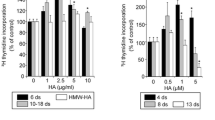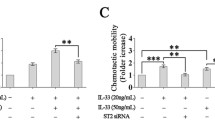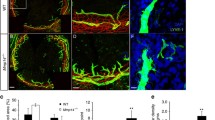Abstract
LL-37, the only member of the cathelicidin family of cationic antimicrobial peptides in humans has been shown to exhibit a wide variety of biological actions in addition to its antimicrobial activity. However, the lymphangiogenic effect of LL-37 has not been elucidated yet. In this study, we examined the effects of LL-37 on lymphangiogenesis and evaluated the underlying molecular mechanisms. LL-37 treatment significantly increased the migration and tube-like formation of human dermal lymphatic microvascular endothelial cells (HDLECs) and promoted the expression of lymphangiogenic factor in HDLECs. Treatment with LL-37 increased phosphorylation of ERK and Akt proteins in HDLECs, and pretreatment with ERK and Akt inhibitors significantly blocked the LL-37-induced HDLEC migration and tube-like formation. Furthermore, to investigate the involvement of formyl peptide receptor-like 1 (FPRL1) signaling in LL-37-induced lymphangiogenesis, HDLECs were treated with an FPRL1 antagonist. Pretreatment with the FPRL1 antagonist inhibited LL-37-induced phosphorylation of ERK and Akt proteins and attenuated LL-37-induced HDLEC migration and tube-like formation. These data indicated that LL-37 induces lymphangiogenesis in lymphatic endothelial cells via FPRL1, and the activation of the ERK and Akt-dependent signaling pathways.





Similar content being viewed by others

References
Falanga V (2005) Wound healing and its impairment in the diabetic foot. Lancet 366:1736–1743. https://doi.org/10.1016/S0140-6736(05)67700-8
Asai J, Takenaka H, Hirakawa S, Sakabe J, Hagura A, Kishimoto S, Maruyama K, Kajiya K, Kinoshita S, Tokura Y, Katoh N (2012) Topical simvastatin accelerates wound healing in diabetes by enhancing angiogenesis and lymphangiogenesis. Am J Pathol 181:2217–2224. https://doi.org/10.1016/j.ajpath.2012.08.023
Tammela T, Alitalo K (2010) Lymphangiogenesis: molecular mechanisms and future promise. Cell 140:460–476. https://doi.org/10.1016/j.cell.2010.01.045
Tanoue R, Koi K, Yamashita J (2015) Effect of alendronate on bone formation during tooth extraction wound healing. J Dent Res 94:1251–1258. https://doi.org/10.1177/0022034515592867
Varricchi G, Loffredo S, Galdiero MR, Marone G, Cristinziano L, Granata F, Marone G (2018) Innate effector cells in angiogenesis and lymphangiogenesis. Curr Opin Immunol 53:152–160. https://doi.org/10.1016/j.coi.2018.05.002
Deng Y, Zhang X, Simons M (2015) Molecular controls of lymphatic VEGFR3 signaling. Arterioscler Thromb Vasc Biol 35:421–429. https://doi.org/10.1161/ATVBAHA.114.304881
Zasloff M (2002) Antimicrobial peptides of multicellular organisms. Nature 415:389–395. https://doi.org/10.1038/415389a
Durr UH, Sudheendra US, Ramamoorthy A (2006) LL-37, the only human member of the cathelicidin family of antimicrobial peptides. Biochim Biophys Acta 1758:1408–1425. https://doi.org/10.1016/j.bbamem.2006.03.030
Ahmed A, Siman-Tov G, Hall G, Bhalla N, Narayanan A (2019) Human Antimicrobial peptides as therapeutics for viral infections. Viruses. https://doi.org/10.3390/v11080704
Bachrach G, Chaushu G, Zigmond M, Yefenof E, Stabholz A, Shapira J, Merrick J, Chaushu S (2006) Salivary LL-37 secretion in individuals with Down syndrome is normal. J Dent Res 85:933–936. https://doi.org/10.1177/154405910608501012
Takeuchi Y, Nagasawa T, Katagiri S, Kitagawara S, Kobayashi H, Koyanagi T, Izumi Y (2012) Salivary levels of antibacterial peptide (LL-37/hCAP-18) and cotinine in patients with chronic periodontitis. J Periodontol 83:766–772. https://doi.org/10.1902/jop.2011.100767
Turkoglu O, Emingil G, Eren G, Atmaca H, Kutukculer N, Atilla G (2017) Gingival crevicular fluid and serum hCAP18/LL-37 levels in generalized aggressive periodontitis. Clin Oral Investig 21:763–769. https://doi.org/10.1007/s00784-016-1834-z
Woo JS, Jeong JY, Hwang YJ, Chae SW, Hwang SJ, Lee HM (2003) Expression of cathelicidin in human salivary glands. Arch Otolaryngol Head Neck Surg 129:211–214. https://doi.org/10.1001/archotol.129.2.211
Zasloff M (2002) Innate immunity, antimicrobial peptides, and protection of the oral cavity. Lancet 360:1116–1117. https://doi.org/10.1016/S0140-6736(02)11239-6
Xhindoli D, Pacor S, Benincasa M, Scocchi M, Gennaro R, Tossi A (2016) The human cathelicidin LL-37–A pore-forming antibacterial peptide and host-cell modulator. Biochim Biophys Acta 1858:546–566. https://doi.org/10.1016/j.bbamem.2015.11.003
Chotjumlong P, Bolscher JG, Nazmi K, Reutrakul V, Supanchart C, Buranaphatthana W, Krisanaprakornkit S (2013) Involvement of the P2X7 purinergic receptor and c-Jun N-terminal and extracellular signal-regulated kinases in cyclooxygenase-2 and prostaglandin E2 induction by LL-37. J Innate Immun 5:72–83. https://doi.org/10.1159/000342928
Ramos R, Silva JP, Rodrigues AC, Costa R, Guardao L, Schmitt F, Soares R, Vilanova M, Domingues L, Gama M (2011) Wound healing activity of the human antimicrobial peptide LL37. Peptides 32:1469–1476. https://doi.org/10.1016/j.peptides.2011.06.005
Koczulla R, von Degenfeld G, Kupatt C, Krotz F, Zahler S, Gloe T, Issbrucker K, Unterberger P, Zaiou M, Lebherz C, Karl A, Raake P, Pfosser A, Boekstegers P, Welsch U, Hiemstra PS, Vogelmeier C, Gallo RL, Clauss M, Bals R (2003) An angiogenic role for the human peptide antibiotic LL-37/hCAP-18. J Clin Invest 111:1665–1672. https://doi.org/10.1172/JCI17545
Yu Y, Zhang Y, Zhang Y, Lai Y, Chen W, Xiao Z, Zhang W, Jin M, Yu B (2017) LL-37-induced human mast cell activation through G protein-coupled receptor MrgX2. Int Immunopharmacol 49:6–12. https://doi.org/10.1016/j.intimp.2017.05.016
Nagaoka I, Tamura H, Hirata M (2006) An antimicrobial cathelicidin peptide, human CAP18/LL-37, suppresses neutrophil apoptosis via the activation of formyl-peptide receptor-like 1 and P2X7. J Immunol 176:3044–3052. https://doi.org/10.4049/jimmunol.176.5.3044
Tjabringa GS, Aarbiou J, Ninaber DK, Drijfhout JW, Sorensen OE, Borregaard N, Rabe KF, Hiemstra PS (2003) The antimicrobial peptide LL-37 activates innate immunity at the airway epithelial surface by transactivation of the epidermal growth factor receptor. J Immunol 171:6690–6696. https://doi.org/10.4049/jimmunol.171.12.6690
Liu Z, Yuan X, Liu M, Fernandes G, Zhang Y, Yang S, Ionita CN, Yang S (2018) Antimicrobial Peptide Combined with BMP2-Modified Mesenchymal Stem Cells Promotes Calvarial Repair in an Osteolytic Model. Mol Ther 26:199–207. https://doi.org/10.1016/j.ymthe.2017.09.011
Suarez-Carmona M, Hubert P, Gonzalez A, Duray A, Roncarati P, Erpicum C, Boniver J, Castronovo V, Noel A, Saussez S, Peulen O, Delvenne P, Herfs M (2014) DeltaNp63 isoform-mediated beta-defensin family up-regulation is associated with (lymph)angiogenesis and poor prognosis in patients with squamous cell carcinoma. Oncotarget 5:1856–1868. https://doi.org/10.18632/oncotarget.1819
Yang Y, Choi H, Seon M, Cho D, Bang SI (2016) LL-37 stimulates the functions of adipose-derived stromal/stem cells via early growth response 1 and the MAPK pathway. Stem Cell Res Ther 7:58. https://doi.org/10.1186/s13287-016-0313-4
Kittaka M, Shiba H, Kajiya M, Ouhara K, Takeda K, Kanbara K, Fujita T, Kawaguchi H, Komatsuzawa H, Kurihara H (2013) Antimicrobial peptide LL37 promotes vascular endothelial growth factor-A expression in human periodontal ligament cells. J Periodontal Res 48:228–234. https://doi.org/10.1111/j.1600-0765.2012.01524.x
Kobayashi S, Kishimoto T, Kamata S, Otsuka M, Miyazaki M, Ishikura H (2007) Rapamycin, a specific inhibitor of the mammalian target of rapamycin, suppresses lymphangiogenesis and lymphatic metastasis. Cancer Sci 98:726–733. https://doi.org/10.1111/j.1349-7006.2007.00439.x
Marshall CJ (1995) Specificity of receptor tyrosine kinase signaling: transient versus sustained extracellular signal-regulated kinase activation. Cell 80:179–185. https://doi.org/10.1016/0092-8674(95)90401-8
Kubota H, Noguchi R, Toyoshima Y, Ozaki Y, Uda S, Watanabe K, Ogawa W, Kuroda S (2012) Temporal coding of insulin action through multiplexing of the AKT pathway. Mol Cell 46:820–832. https://doi.org/10.1016/j.molcel.2012.04.018
Sathe A, Guerth F, Cronauer MV, Heck MM, Thalgott M, Gschwend JE, Retz M, Nawroth R (2014) Mutant PIK3CA controls DUSP1-dependent ERK 1/2 activity to confer response to AKT target therapy. Br J Cancer 111:2103–2113. https://doi.org/10.1038/bjc.2014.534
Lee JG, Song JS, Smith RE, Kay EP (2011) Human corneal endothelial cells employ phosphorylation of p27(Kip1) at both Ser10 and Thr187 sites for FGF-2-mediated cell proliferation via PI 3-kinase. Invest Ophthalmol Vis Sci 52:8216–8223. https://doi.org/10.1167/iovs.11-8213
Hayashi H, Matsuzaki O, Muramatsu S, Tsuchiya Y, Harada T, Suzuki Y, Sugano S, Matsuda A, Nishida E (2006) Centaurin-alpha1 is a phosphatidylinositol 3-kinase-dependent activator of ERK1/2 mitogen-activated protein kinases. J Biol Chem 281:1332–1337. https://doi.org/10.1074/jbc.M505905200
Lee SY, Lee MS, Lee HY, Kim SD, Shim JW, Jo SH, Lee JW, Kim JY, Choi YW, Baek SH, Ryu SH, Bae YS (2008) F2L, a peptide derived from heme-binding protein, inhibits LL-37-induced cell proliferation and tube formation in human umbilical vein endothelial cells. FEBS Lett 582:273–278. https://doi.org/10.1016/j.febslet.2007.12.015
Saaristo A, Tammela T, Farkkila A, Karkkainen M, Suominen E, Yla-Herttuala S, Alitalo K (2006) Vascular endothelial growth factor-C accelerates diabetic wound healing. Am J Pathol 169:1080–1087. https://doi.org/10.2353/ajpath.2006.051251
Hasegawa S, Nakano T, Torisu K, Tsuchimoto A, Eriguchi M, Haruyama N, Masutani K, Tsuruya K, Kitazono T (2017) Vascular endothelial growth factor-C ameliorates renal interstitial fibrosis through lymphangiogenesis in mouse unilateral ureteral obstruction. Lab Invest 97:1439–1452. https://doi.org/10.1038/labinvest.2017.77
Saaristo A, Veikkola T, Tammela T, Enholm B, Karkkainen MJ, Pajusola K, Bueler H, Yla-Herttuala S, Alitalo K (2002) Lymphangiogenic gene therapy with minimal blood vascular side effects. J Exp Med 196:719–730. https://doi.org/10.1084/jem.20020587
Dorschner RA, Pestonjamasp VK, Tamakuwala S, Ohtake T, Rudisill J, Nizet V, Agerberth B, Gudmundsson GH, Gallo RL (2001) Cutaneous injury induces the release of cathelicidin anti-microbial peptides active against group A Streptococcus. J Invest Dermatol 117:91–97. https://doi.org/10.1046/j.1523-1747.2001.01340.x
Paavonen K, Puolakkainen P, Jussila L, Jahkola T, Alitalo K (2000) Vascular endothelial growth factor receptor-3 in lymphangiogenesis in wound healing. Am J Pathol 156:1499–1504. https://doi.org/10.1016/S0002-9440(10)65021-3
Kim DJ, Lee YW, Park MK, Shin JR, Lim KJ, Cho JH, Kim SC (2014) Efficacy of the designer antimicrobial peptide SHAP1 in wound healing and wound infection. Amino Acids 46:2333–2343. https://doi.org/10.1007/s00726-014-1780-5
Steinstraesser L, Hirsch T, Schulte M, Kueckelhaus M, Jacobsen F, Mersch EA, Stricker I, Afacan N, Jenssen H, Hancock RE, Kindrachuk J (2012) Innate defense regulator peptide 1018 in wound healing and wound infection. PLoS ONE 7:e39373. https://doi.org/10.1371/journal.pone.0039373
Lorena D, Darby IA, Reinhardt DP, Sapin V, Rosenbaum J, Desmouliere A (2004) Fibrillin-1 expression in normal and fibrotic rat liver and in cultured hepatic fibroblastic cells: modulation by mechanical stress and role in cell adhesion. Lab Invest 84:203–212. https://doi.org/10.1038/labinvest.3700023
Rossi A, Gabbrielli E, Villano M, Messina M, Ferrara F, Weber E (2010) Human microvascular lymphatic and blood endothelial cells produce fibrillin: deposition patterns and quantitative analysis. J Anat 217:705–714. https://doi.org/10.1111/j.1469-7580.2010.01306.x
Acknowledgments
This work was in part supported by a Grant-in Aid for Scientific Research B (grant number: 17H04394); and a Grant-in Aid for Scientific Research C (grant number: 18K09687).
Funding
This work was in part supported by a Grant-in Aid for Scientific Research B (Grant Number: 17H04394); and a Grant-in Aid for Scientific Research C (Grant Number: 18K09687).
Author information
Authors and Affiliations
Corresponding author
Ethics declarations
Conflict of interest
The authors declare that there is no conflict of interests.
Research involving human participants or animals
This article does not contain any studies involving human participants or animals.
Additional information
Publisher's Note
Springer Nature remains neutral with regard to jurisdictional claims in published maps and institutional affiliations.
Rights and permissions
About this article
Cite this article
Yanagisawa, T., Ishii, M., Takahashi, M. et al. Human cathelicidin antimicrobial peptide LL-37 promotes lymphangiogenesis in lymphatic endothelial cells through the ERK and Akt signaling pathways. Mol Biol Rep 47, 6841–6854 (2020). https://doi.org/10.1007/s11033-020-05741-8
Received:
Accepted:
Published:
Issue Date:
DOI: https://doi.org/10.1007/s11033-020-05741-8



